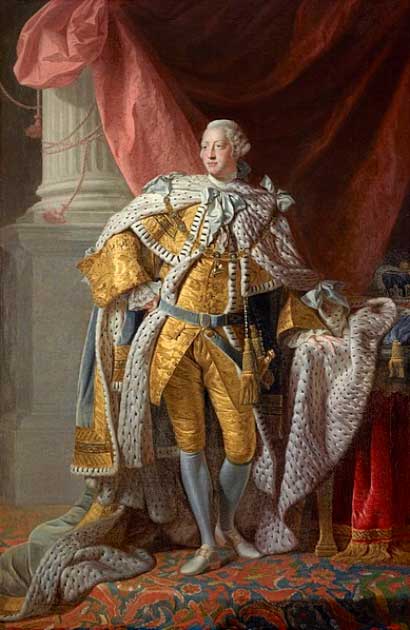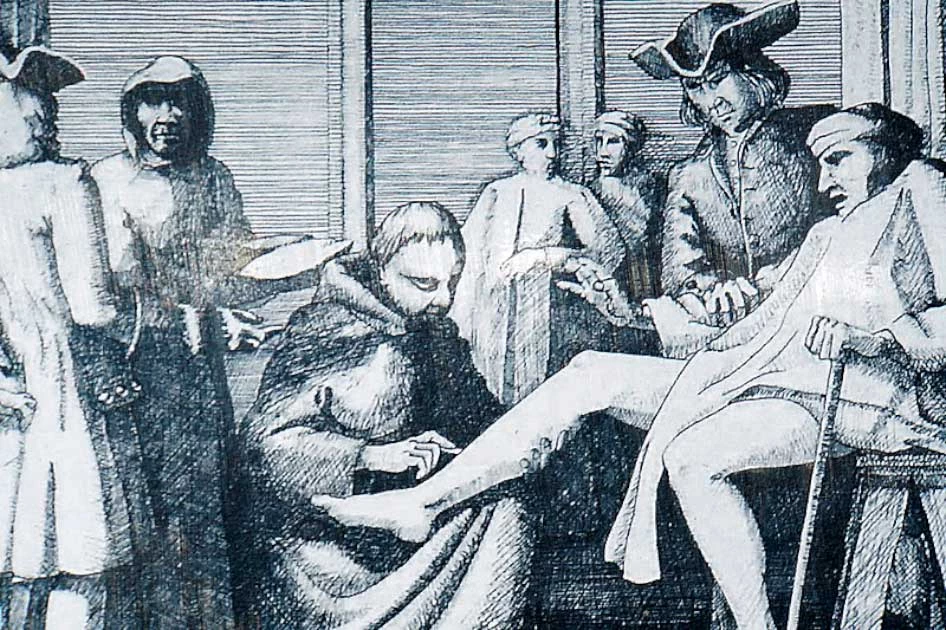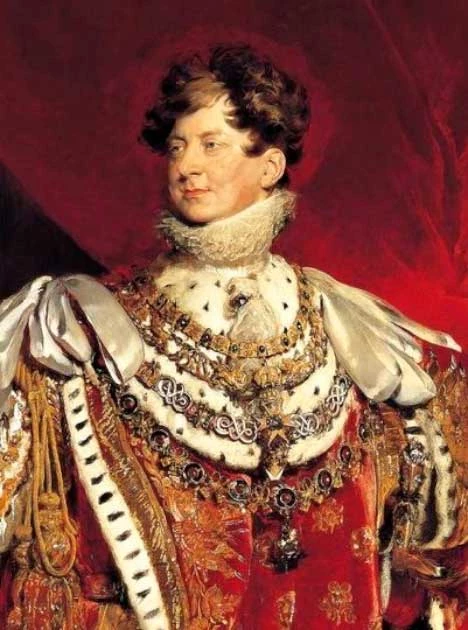Throughout history, there have been many members of the nobility who were thought of as crazy or mad. Charles VI of France, for example, suffered a glass delusion, convinced he was made of glass.
There was Queen Joanna of Castile, called “Juana La Loca,” who could not accept her husband was dead. She had his body exhumed and would go everywhere with him in his casket, but only at night of course, so other women didn’t tempt the dead and embalmed king. Erik XIV of Sweden, another troubled monarch, was so paranoid that if he caught anyone smiling, laughing, or heard whispering, he would sentence them to death for treason.
Many of these mad monarchs have been studied by specialists, trying to understand the root cause of their odd behaviors. The madness ranges from mental illness, underlying health conditions, or even foul play. But the diagnosis of perhaps the most famous “mad” king, George III of England, is still under debate.
The Madness of George III
George William Frederick, was born in 1738 to the ruling British House of Hanover and ascended to the throne as King of the United Kingdom of Great Britain and Ireland. King George III ruled and lived longer than any of his predecessors and had no fewer than 13 children survive to adulthood. During his life, he became known for two things: being the King that lost America, and, in the later stages of his reign, being utterly mad.
The King had experienced episodes of illness during much of his time on the throne. He would usually recover after being given medicine and medical care. However, as he aged, his mental and physical health deteriorated.
After falling ill in 1788, the King and the Royal Family visited Cheltenham Spa. A town in Gloucestershire, England, to relax and recuperate. Sadly things seemed to get worse in the fall of 1788, but not from physical illness. It was his behavior that had worsened.

Faced with the aberrant behaviors, King George III was considered to have gone “mad.” It was common for a person acting strangely or demonstrating symptoms of mental illnesses to be labeled as “mad” and, to an extent, that would be the end of it. Some of the things he experienced at this time were incredibly strange to those around him.
But it seemed clear that George III was not just troubled in mind, but in body too. Some of the physical ailments and peculiarities included stomach pains, headaches, and puzzling blue or brown urine. The King began to develop cataracts, had difficulties sleeping, and was said to have “become yellow in the eyes,” which can be a symptom of jaundice.
There were other things as well. The mad king would exhibit manic behavior, write sentences that were 400 words long, and talk to the point he would lose his voice. He was known to speak for so long that he would foam up at the mouth and on one occasion, during a Christmas celebration shortly before his death, the King talked for 58 hours straight, never taking a break or pausing.
Along with marathons of speaking nonsense came a unique symptom. It was said that the mad king of England’s vocabulary would become “more complex, creative, and colorful.” At times, the king would also suffer from seemingly related seizures.
These could be so intense it required His Majesty’s pages and attendants to sit on top of the king until the episode passed. The king was a very ill man but, in another clue to his diagnosis, would often recover and return to normal for a while before falling ill again.
Medical Care
At the time, medicine was based on the concept of “humorism”. The humoral system was that the body contained four humors and illness was due to an imbalance of humors. The humors were blood, phlegm, yellow bile, and black bile.

To fix an imbalance, medical wisdom stated that a person needed to eliminate the extra humor in their body. This was done through bloodletting, consuming an emetic, taking a diuretic, and laxatives.
For King George III, his doctors performed bloodletting, used emetics, and prescribed medicine. At the time, medicine could contain things like arsenic and other toxic substances. Caustic poultices were applied to his skin, and he was restrained with a straight jacket (invented in 1772), or a doctor would gag the King and tie him to a chair until he “became calm.”
But by the end of mad King George’s life it was clear that these “treatments” were having no effect and he was considered insane and deranged beyond recovery. He was blind, in pain from rheumatism, and had developed dementia.
The most tragic part was due to his condition; he didn’t understand or know that his beloved wife had died in 1614. And finally in 1820, after a period where his son ruled as Prince Regent and the king was considered fully incapacitated, King George III died of pneumonia at the age of 82. He remains England’s longest reigning king.
Possible Causes
Scholars today believe there are three possibilities to explain King George III’s madness. The first is arsenic poisoning, the second is the disorder porphyria, and the third is a combination of mental illness and potentially bipolar disorder.
In 2005, scientists ran a test on some hair samples from King George III and found traces of arsenic. Arsenic is a natural element in the air, soil, water, plants, and animals at low levels. The king could have consumed low doses of the poison by eating and drinking daily.
Maybe he was poisoned with arsenic by his doctor, accidentally. It is unknown what medication King George was given, but it is possible that it had arsenic in it. And arsenic poisoning may very well have made George III mad.
Another theory is that he could have had porphyria, the term for a group of genetic liver and blood disorders affecting the skin and the nervous system. The disease’s physical and nervous system symptoms, such as pain, muscle weakness, seizures, anxiety, and hallucinations, closely match some of the king’s symptoms.
King George, it was rumored, once shook a tree’s hand because he thought it was the King of Prussia, suggesting a powerful hallucination. Persuaded by this, and by the discolored urine which can also be a sign of porphyria, some doctors and historians believe this is what caused the madness. However others are unconvinced, noting the hereditary nature of porphyria and the (comparative) lack of madness in the king’s blood relatives.

The third explanation could be that the king had bipolar disorder: King George III might have been mentally ill. Bipolar disorder causes mood episodes like mania and deep depression. A person can be extremely happy or irritable, and episodes can last for long periods. Individuals with bipolar disorder can also function normally for periods, something the King often did.
There are two forms of bipolar disorder the king may have had, Bipolar 1 or Bipolar 2. The king demonstrated some symptoms of Bipolar 1 in his behaviors like increased and faster speech; after all he did talk for 58 hours once. The wildly changing subjects and increased activity are signs of a manic episode. He could have been having a hypomanic episode that has the same symptoms of mania but is less intense.
The king showed signs of having major depressive episodes as well. After the death of his favorite daughter, and many times before, the King was noted to be greatly distressed. He is said to cry for hours, have trouble sleeping, and have thoughts of death. A maid wrote that some days he would plead for death to come.
A diagnosis of bipolar 2 requires someone to have at least one major depressive and one hypomanic episode in their life. People with bipolar 2 seek help because their depression is potentially dangerous to them. Hypomania is weaker, so a person feels good and can make someone more productive. Based on King George III’s symptoms, he likely had bipolar 1 disorder that went untreated due to a lack of knowledge about mental illnesses.
It is impossible to definitively say what caused King George III to become “The mad King George”. His symptoms cannot be tested medically or be subject to an accurate mental health assessment using modern procedures. Whatever the cause might have been, King George III will forever be known as the utterly mad king.
Top Image: “Mad” king George in later years, captured by Henry Meyer. Source: Henry Hoppner Meyer / Public Domain.
By Lauren Dillon